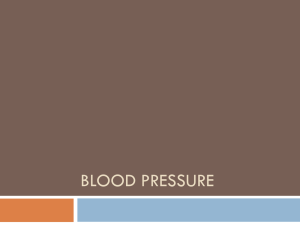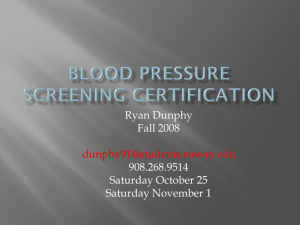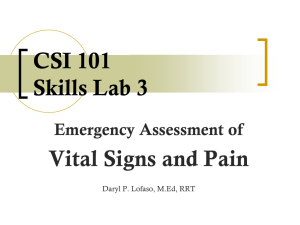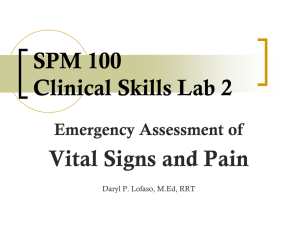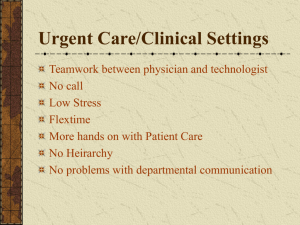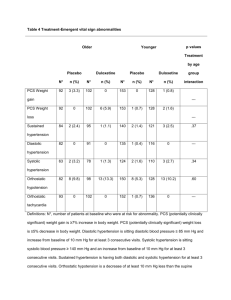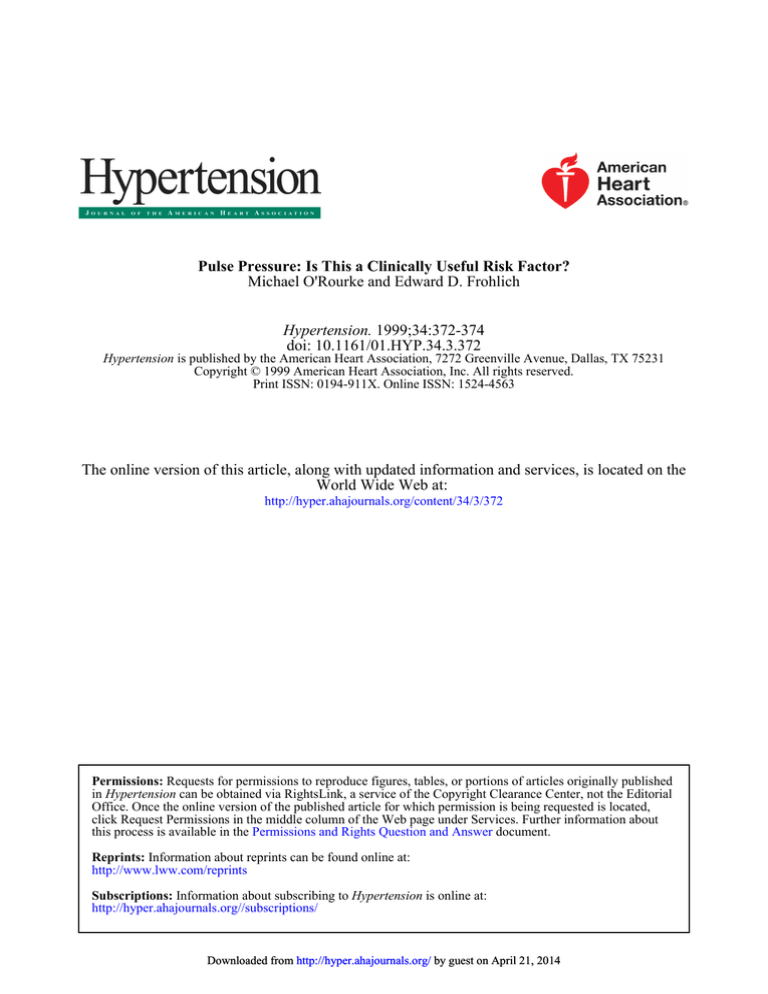
Pulse Pressure: Is This a Clinically Useful Risk Factor?
Michael O'Rourke and Edward D. Frohlich
Hypertension. 1999;34:372-374
doi: 10.1161/01.HYP.34.3.372
Hypertension is published by the American Heart Association, 7272 Greenville Avenue, Dallas, TX 75231
Copyright © 1999 American Heart Association, Inc. All rights reserved.
Print ISSN: 0194-911X. Online ISSN: 1524-4563
The online version of this article, along with updated information and services, is located on the
World Wide Web at:
http://hyper.ahajournals.org/content/34/3/372
Permissions: Requests for permissions to reproduce figures, tables, or portions of articles originally published
in Hypertension can be obtained via RightsLink, a service of the Copyright Clearance Center, not the Editorial
Office. Once the online version of the published article for which permission is being requested is located,
click Request Permissions in the middle column of the Web page under Services. Further information about
this process is available in the Permissions and Rights Question and Answer document.
Reprints: Information about reprints can be found online at:
http://www.lww.com/reprints
Subscriptions: Information about subscribing to Hypertension is online at:
http://hyper.ahajournals.org//subscriptions/
Downloaded from http://hyper.ahajournals.org/ by guest on April 21, 2014
Editorial
Pulse Pressure
Is This a Clinically Useful Risk Factor?
Michael O’Rourke, Edward D. Frohlich
A
gain, the Framingham group has provided another
surprise to the medical community with publication
of its longitudinal follow-up study of persons over 50
years of age that has linked cardiovascular (and in particular
coronary) mortality with pulse pressure.1 In this study,
mortality was related independently with initial systolic,
diastolic, and pulse pressure, but the strongest association
was with pulse pressure, and when systolic pressure was
initially considered, there was a negative association with
diastolic pressure. In other words, for a given systolic
pressure, lower diastolic pressure was associated with greater
mortality.
A series of questions arise from this study. What corroboration does it have from other studies on similar cohorts?
How does one reconcile the findings with the wellestablished association of coronary and stroke mortality with
diastolic pressure?2,3 What possible mechanism can explain a
greater association between coronary mortality and greater
pulse pressure (or lower diastolic pressure)? And above all,
what implications does this study have to patient
management?
Corroboration
For some 30 years, the Framingham group has pointed to a more
robust association between systolic, rather than diastolic, pressure and cardiovascular events4,5 and has used systolic, not
diastolic, pressure in their predictive tables. Fifteen years ago,
Fisher6 challenged the preoccupation with diastolic rather than
systolic pressure, and soon after, Dustan7 referred to a change in
hypertensive disease, with problems shifting from the young and
middle-aged subjects with diastolic hypertension to older subjects with systolic hypertension. In 1989, Darne et al8 noted that
pulse pressure added further risk to patients with elevated
diastolic or mean pressure, at least with respect to cerebral
events. A series of prospective and cross-sectional studies has
followed that has associated pulse pressure with cardiovascular
events.9 –13 The most recent, the follow-up of nearly 20 000
initially healthy Parisians, followed up for 19 years, showed that
the relationship between pulse pressure and death rates existed
Received June 18, 1999; accepted July 15, 1999.
The opinions expressed in this editorial are not necessarily those of the
editors or of the American Heart Association.
From the University of New South Wales, St Vincent’s Hospital,
Sydney, Australia (M.O.), and the Alton Ochsner Medical Foundation,
New Orleans, La (E.D.F.).
Correspondence to Michael O’Rourke, MD, DSc, Professor of Medicine, St Vincent’s Clinic, University of New South Wales, Suite 810,
Level 8, 438 Victoria Street, Darlinghurst, Sydney 2010, Australia.
(Hypertension. 1999;34:372-374.)
© 1999 American Heart Association, Inc.
Hypertension is available at http://www.hypertensionaha.org
for persons with normal,12 as well as raised, systolic pressure,10
which was also seen in the Framingham cohort.1
Reconciliation
The second question is how to reconcile these recent findings
with the hallowed concepts of diastolic pressure elevation,
and especially with the seemingly irrefutable meta-analyses
published by MacMahon et al in 1990 and 1999.2,3 The
original idea that elevated diastolic pressure is bad and that
elevated systolic pressure is good is attributed to Sir James
MacKenzie,14,15 whose books on the heart, arteries, and veins
established cardiology as a discipline in the early part of the
twentieth century. A study of these books16 reveals that
MacKenzie had a much more sophisticated view of sphygmomanometric measurements and that the simplistic notion
that related elevated diastolic pressure to increased arteriolar
tone as bad, and elevated systolic pressure to cardiac strength
as good, was inserted by another person in the last edition of
MacKenzie’s textbook, which was published posthumously.
Other criticisms of this simplistic notion were voiced by
Fisher in his appropriately titled review “The Ascendancy of
Diastolic Blood Pressure Over Systolic Blood Pressure”.6
But what of the meta-analyses? MacMahon’s 1990 review2
published results of studies reported between 1963 and 1989,
in which subjects were recruited between 1938 and 1983.
These subjects were quite different from those reported by
Franklin et al,1 in that they were generally younger, their
diastolic pressure covered a much wider range (from ,69 to
.110 mm Hg), and they were recruited at a time when a
diastolic pressure of up to 105 mm Hg was considered only
moderately elevated (and elevated systolic pressure was
considered irrelevant), when therapy was not as effective or
as well tolerated as it is today, when most subjects were not
treated with any therapy at all, and when introduction of
therapy was based on the level of diastolic pressure alone. In
the most recent review,3 subjects studied in China and Japan
were analized, and many of these same comments can be
made even though recruitment occurred at a later time.
The MacMahon meta-analyses2,3 referred to persons who
represent the old problem of diastolic hypertension as described by Dustan,7 not the new problem she described,
which is better represented by the Framingham cohort of
patients over 50 years old than most of the others referred to
above. Although these criticisms are in accord with our
argument, it should be said that the most recent follow-up by
MacMahon and colleagues, not yet published, still shows an
association between mortality and diastolic pressure and no
definite relationship with pulse pressure. It is possible that the
phenomenon of pulse-wave amplification in young subjects
372
Downloaded from http://hyper.ahajournals.org/
by guest on April 21, 2014
O’Rourke and Frohlich
may have skewed the data for those in their twenties and
thirties16 (see below).
Pulse Pressure: A Clinical Risk?
373
the central aorta and brachial artery.16 This, too, clouds
interpretation of pulse pressure as a risk factor in persons
under age 40.
Mechanism
With respect to mechanisms, we are on stronger ground.
Elevated pulse pressure causes greater stretch of arteries,
induces fatigue and fracture of elastic elements more quickly,16 is more likely to hasten development and ultimate
rupture of aneurysms, and is more likely to hasten development of the intimal damage that leads to atherosclerosis and
thrombotic events.16 Elevated pressure during systole favors
left ventricular hypertrophy, predisposes to left ventricular
failure, and increases myocardial oxygen demands, whereas
absolute or relative lower values of pressure throughout
diastole are a potential limiting factor to coronary perfusion
and so predispose to ischemia, especially when, as in left
ventricular hypertrophy, diastolic perfusion time is shortened.16 From a mechanistic viewpoint, elevation of pulse
pressure or systolic pressure or both is potentially deleterious,
and so is reduction of pressure during diastole.16
Elevated pulse pressure is usually regarded as a manifestation of increased arterial stiffness. But there are other
diseases in which pulse pressure is elevated and in which
increased pulse pressure may contribute to vascular and
cardiac events. The most obvious is aortic coarctation, in
which pulse pressure is markedly increased in upper-body
arteries, and in which arterial complications such as aortic
medionecrosis and dissection and cerebral aneurysms and
hemorrhage are much more frequent than in persons with
essential hypertension and a similar level of mean arterial
pressure.17 Aortic valve incompetence, patent ductus arteriosus, and Paget’s disease are other examples in which high
pulse pressure is due to high stroke volume, not aortic
stiffness or aortic coarctation. In these conditions, the pathophysiological principles referred to above no doubt apply, but
progress of the disease is usually attributed to other problems
(eg, left ventricular enlargement and failure, pulmonary
hypertension, fractures, and sarcoma).
There is another mechanistic factor, whose relevance has
yet to be assessed, and this is the difference in pulse pressure
and systolic pressure between the aorta and upper limb
arteries where pressure is measured clinically. Diastolic and
mean arterial pressure show little difference between central
and peripheral arteries,18 but in young adults, brachial pulse
pressure may be 50% greater than in the aorta and systolic
pressure may be 10 to 20 mm Hg higher than in the
aorta.16,18,19 In older and hypertensive subjects, these differences are small16 and probably irrelevant in the Framingham
Heart Study. However, this point is a potential source of
variability for measured systolic pressure in younger subjects,
such as those entering the work force or applying for
insurance policies, and may have clouded assessment of the
importance of systolic and pulse pressure in actuarial and
other studies.
The NHANES study20 showed a progressive decrease in
pulse pressure between adolescence and middle age despite
an acknowledged increase in aortic stiffness over this age
range.16 Such a phenomenon can only be explained on the
basis of changing amplification of the pulse wave between
Implications
Finally, what are the clinical implications of the recent
Framingham and other studies? Framingham refers only to
persons over 50 years of age. In such middle-aged and older
subjects, systolic pressure values are all-important, and decisions on treatment should be based on such values, as
demonstrated clearly by SHEP,21 Syst-Eur,22 and other studies.4,5,8 –11 What extra value could be provided by the diastolic
pressure? The published data at present indicate a greater risk
for a person with a persistent blood pressure of 160/
70 mm Hg than 160/90 mm Hg. Clearly, both should be
treated. But with treatment, who might be expected to do
better, and what should be the goals for diastolic pressure?
We simply do not know at present, and there is a very real
need to conduct trials on therapy for patients with elevated
pulse pressure at different levels of diastolic pressure, as well
as to further confirm the fascinating data emanating from
Framingham. The common clinical problem of elevated
blood pressure continues to provide unexpected surprises and
new issues to be explored and untangled.
Let us explore two other examples concerning patients
with more severe degrees of hypertensive disease. The first
might be a young, high-risk patient with severe diastolic
hypertension (eg, 188/124 mm Hg; pulse pressure
64 mm Hg). This is the classic patient with diastolic hypertension included in the earlier multicenter trials who benefited from antihypertensive therapy. The patient’s blood
pressure might have been reduced to 142/64 mm Hg (pulse
pressure 78 mm Hg). This patient’s risk would have been
increased further if we refer to the recent studies.9 –13 Alternatively, the second example relates to a very different patient
population emphasized by Dustan,7 with risk associated with
systolic hypertension (190/88 mm Hg) with pulse pressure of
102 mm Hg that is greater than that of the previous patient
with severe diastolic hypertension. That risk is also markedly
diminished by antihypertensive therapy to 142/78 mm Hg
(pulse pressure 64 mm Hg); but this patient’s improved risk
(by pulse pressure) is precisely the same as that of the
untreated patient with severe diastolic hypertension. We must
conclude, for the time being, that antihypertensive therapy
must have markedly benefited both patients. The question
remains, however: are their risks comparable?
Clearly, prospective studies comparing these two groups
are necessary. Perhaps the answer can be provided by
plumbing the data of past multicenter studies (eg, Veterans
Administration Cooperative Study, Hypertension Detection
Follow Up Program, the Systolic Hypertension in the Elderly,
and Stop-Hypertension Trials). These data may be in their
respective repositories and may be readily available to their
respective investigators’ review. If retrieval of these data is
possible, we may soon have some very important answers in
a shorter time than it would take to initiate lengthy and
expensive prospective trials. We may then have answers
relative to (1) the validity of comparing risk data before and
during therapy; (2) whether equivalent pulse pressure data
Downloaded from http://hyper.ahajournals.org/ by guest on April 21, 2014
374
Hypertension
September 1999
before and during therapy are comparable; and (3) whether
the pulse pressure data generated prior to treatment are of
value in evaluating efficacy of therapy. One such report,
reanalyzing the SHEP data, appears in this issue of Hypertension.23 Another report, reanalyzing the British MRC trial
data, has just been published in the Journal of Hypertension.24 Yet another, reanalyzing the SYSTEUR data, was
presented orally at the most recent European Society of
Hypertension meeting in June 1999. All three support views
presented here and provide new quantitative information on
elevation of mean pressure and of pulse pressure in older
persons.
References
1. Franklin SS, Khan SA, Wong ND, Larson MG, Levy D. Is pulse pressure
useful in predicting coronary heart disease? The Framingham Heart
Study. Circulation. 1999;100:354 –360.
2. MacMahon S, Peto R, Cutler J, Collins R, Sorlie P, Neaton J, Abbott R,
Godwin J, Dyer A, Stamler J. Blood pressure, stroke, and coronary heart
disease. Lancet. 1990;335:765–774.
3. Rodgers A, MacMahon S, Yee T, Clark T, for the Eastern Stroke and
Coronary Heart Disease Collaboration Research Group. Blood pressure,
cholesterol, and stroke in eastern Asia. Lancet. 1998;352:1801–1807.
4. Kannel WB, Gordon T, Schwartz MJ. Systolic versus diastolic blood
pressure and risk of coronary heart disease: the Framingham study. Am J
Cardiol. 1971;27:335–346.
5. Kannel WB, Wolf PA, McGee DL. Systolic blood pressure, arterial
rigidity and risk of stroke: the Framingham Study. JAMA. 1981;245:
1225–1229.
6. Fisher CM. The ascendancy of diastolic blood pressure over systolic.
Lancet. 1985;2:1349 –1350.
7. Dustan HP. Isolated systolic hypertension: a long neglected cause of
cardiovascular complications. Am J Med. 1989;86:368 –369.
8. Darne B, Girerd X, Safar M, Cambien F, Guize L. Pulsatile versus steady
component of blood pressure: a cross-sectional analysis and a prospective
analysis on cardiovascular mortality. Hypertension. 1989;13:392– 400.
9. Madhaven S, Ooi WL, Cohen H, Alderman MH. Relation of pulse
pressure and blood pressure reduction to the incidence of myocardial
infarction. Hypertension. 1994;23:395– 401.
10. Benetos A, Safar M, Rudnichi A, Smulyan H, Richard JL, Ducimetière P,
Guize L. Pulse pressure: a predictor of long-term cardiovascular mortality
in a French male population. Hypertension. 1997;30:1410 –1415.
11. Mitchell GF, Moye LA, Braunwald E, Rouleau JL, Bernstein V, Geltman
EM, Flaker GC, Pfeffer MA. Sphygmomanometrically determined pulse
12.
13.
14.
15.
16.
17.
18.
19.
20.
21.
22.
23.
24.
pressure is a powerful independent predictor of recurrent events after
myocardial infarction in patients with impaired left ventricular function.
Circulation. 1997;96:4254 – 4260.
Benetos A, Rudnichi A, Safar M, Guize L. Pulse pressure and cardiovascular mortality in normotensive and hypertensive subjects. Hypertension.
1998;32:560 –564.
Franklin SS, Sutton-Tyrell K, Belle SH, Weber MA, Kuller LW. The
importance of pulsatile components of hypertension in predicting carotid
stenosis in older adults. J Hypertens. 1997;15:1143–1150.
MacKenzie J. Principles of Diagnosis and Treatment of Heart Affectations. 2nd ed. London, UK: Frowde; 1917.
MacKenzie J. Principles of Diagnosis and Treatment of Heart Affectations. 3rd ed. London, UK: Oxford University Press; 1926.
Nichols WW, O’Rourke MF. McDonald’s Blood Flow in Arteries. 4th ed.
London, UK: Arnold; 1998.
Campbell M. Natural history of coarctation of the aorta. Br Heart J.
1970;32:633– 640.
Pauca AL, Wallenhaupt SL, Kon ND, Tucker WY. Does radial artery
pressure accurately reflect aortic pressure? Chest. 1992;102:1193–1198.
Kroeker EJ, Wood EH. Comparison of simultaneously recorded central
and peripheral arterial pressure pulses during rest, exercise and tilted
position in man. Circ Res. 1955;3:623– 632.
Burt VL, Whelton P, Roccella EJ, Brown C, Cutler JA, Higgins M, Horan
MJ, Labarthe D. Prevalence of hypertension in the U. S. adult population:
results from the Third National Health and Nutrition Examination Survey,
1988 –1991. Hypertension. 1995;25:305–313.
SHEP Cooperative Research Group. Prevention of stroke by antihypertensive drug treatment in older persons with isolated systolic hypertension: final results of the Systolic Hypertension in the Elderly Program
(SHEP). JAMA. 1991;265:3255–3264.
Staessen JA, Fagaro R, Thijs L, Celis H, Arabidze GG, Birkenhager WH,
Bulpitt CJ, deLeeuw PW, Dollery CT, Fletcher AE, Forette F, Leonetti G,
Nachev C, O’Brien ET, Rosenfeld J, Rodicio JL, Tuomilehto J, Zanchetti
A, the Systolic Hypertension in Europe (Syst-Eur) trial investigators.
Randomised double-blind comparison of placebo and active treatment for
older patients with isolated systolic hypertension. Lancet. 1997;350:
757–764.
Domanski MJ, David BR, Pfeffer MA, Kastantin M, Mitchell GF.
Isolated systolic hypertension: prognostic information provided by pulse
pressure. Hypertension. 1999;34:375–380.
Millar JA, Lever AF, Burke V. Pulse pressure as a risk factor for
cardiovascular events in the MRC Mild Hypertension Trial. J Hyperten.
1999;17:1– 8.
KEY WORDS: pulse pressure
n risk factors n
Downloaded from http://hyper.ahajournals.org/ by guest on April 21, 2014
editorials

